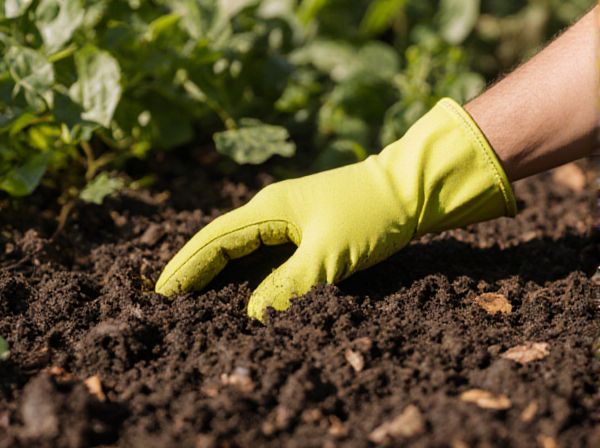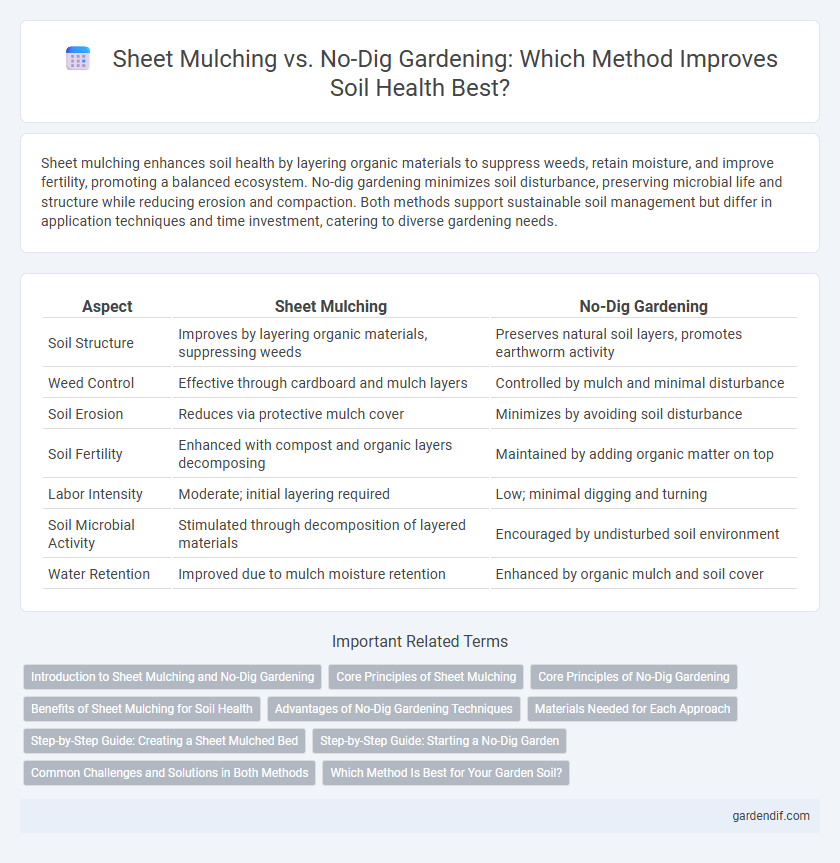
Sheet mulching vs No-dig gardening Illustration
Sheet mulching enhances soil health by layering organic materials to suppress weeds, retain moisture, and improve fertility, promoting a balanced ecosystem. No-dig gardening minimizes soil disturbance, preserving microbial life and structure while reducing erosion and compaction. Both methods support sustainable soil management but differ in application techniques and time investment, catering to diverse gardening needs.
Table of Comparison
| Aspect | Sheet Mulching | No-Dig Gardening |
|---|---|---|
| Soil Structure | Improves by layering organic materials, suppressing weeds | Preserves natural soil layers, promotes earthworm activity |
| Weed Control | Effective through cardboard and mulch layers | Controlled by mulch and minimal disturbance |
| Soil Erosion | Reduces via protective mulch cover | Minimizes by avoiding soil disturbance |
| Soil Fertility | Enhanced with compost and organic layers decomposing | Maintained by adding organic matter on top |
| Labor Intensity | Moderate; initial layering required | Low; minimal digging and turning |
| Soil Microbial Activity | Stimulated through decomposition of layered materials | Encouraged by undisturbed soil environment |
| Water Retention | Improved due to mulch moisture retention | Enhanced by organic mulch and soil cover |
Introduction to Sheet Mulching and No-Dig Gardening
Sheet mulching enhances soil health by layering organic materials like cardboard, compost, and mulch to suppress weeds, retain moisture, and enrich microbial activity. No-dig gardening preserves soil structure by eliminating disturbance, promoting natural decomposition, and supporting beneficial organisms. Both methods improve soil fertility and reduce erosion but differ in application techniques and maintenance requirements.
Core Principles of Sheet Mulching
Sheet mulching relies on layering organic materials such as cardboard, compost, and mulch to suppress weeds, improve soil structure, and enhance moisture retention. This method fosters soil fertility by promoting microbial activity and nutrient cycling without disturbing soil layers. It contrasts with no-dig gardening by emphasizing the creation of a nutrient-rich, protective blanket rather than relying solely on minimal soil disturbance.
Core Principles of No-Dig Gardening
No-dig gardening emphasizes maintaining soil structure by avoiding turning or disturbing the soil, which preserves beneficial microbial life and earthworm activity. It involves layering organic materials on the soil surface to suppress weeds, retain moisture, and gradually enrich the soil with nutrients through natural decomposition. This method contrasts with sheet mulching primarily by focusing on minimal soil disturbance rather than creating a new soil base, promoting healthier soil ecology for sustainable plant growth.
Benefits of Sheet Mulching for Soil Health
Sheet mulching improves soil health by enhancing moisture retention, suppressing weeds, and increasing organic matter through gradual decomposition of layered materials like cardboard and compost. This method boosts microbial activity and nutrient availability, promoting robust soil structure and fertility. Unlike no-dig gardening, sheet mulching actively builds soil layers, accelerating soil regeneration and reducing erosion.
Advantages of No-Dig Gardening Techniques
No-dig gardening preserves soil structure by minimizing disturbance, which enhances microbial activity and promotes healthier root development. This technique reduces weed growth naturally and retains soil moisture more effectively than sheet mulching. It also fosters nutrient cycling and improves long-term soil fertility by allowing organic matter to decompose in place.
Materials Needed for Each Approach
Sheet mulching requires layers of cardboard or newspaper, organic compost, and mulch such as straw or wood chips to suppress weeds and build soil fertility. No-dig gardening primarily relies on applying a thick layer of compost directly on the soil surface without disturbing the underlying soil structure, often supplemented by mulch for moisture retention. Both approaches emphasize organic materials but differ in the initial layering and soil coverage techniques used.
Step-by-Step Guide: Creating a Sheet Mulched Bed
Sheet mulching involves layering organic materials such as cardboard, compost, and mulch directly on the soil to suppress weeds and improve soil fertility, contrasting with no-dig gardening that relies on minimal soil disturbance. Begin by clearing the area, then lay down a cardboard layer to block sunlight and prevent weed growth, followed by successive layers of compost and mulch to build nutrient-rich, moisture-retentive soil. This process enhances soil structure, promotes microbial activity, and accelerates plant growth without the need for tilling or digging.
Step-by-Step Guide: Starting a No-Dig Garden
Step-by-step guide to starting a no-dig garden begins with selecting a suitable site free of weeds and grass, then layering organic materials such as cardboard or newspaper to suppress existing vegetation. Next, apply thick layers of compost and mulch, allowing soil organisms to break down the layers naturally, which enhances soil structure and fertility. Regularly adding organic mulch maintains moisture, prevents weeds, and supports microbial life for sustainable, nutrient-rich soil development without disturbance.
Common Challenges and Solutions in Both Methods
Sheet mulching and no-dig gardening both face challenges such as weed control, soil compaction, and nutrient management, requiring tailored strategies for effective growth. Common solutions include using organic mulch layers to suppress weeds, regularly adding compost to maintain soil fertility, and avoiding heavy foot traffic to prevent compaction. Integrating natural soil amendments like biochar or worm castings enhances microbial activity and supports sustainable soil health in both approaches.
Which Method Is Best for Your Garden Soil?
Sheet mulching improves soil structure by layering organic materials that suppress weeds and retain moisture, promoting microbial activity. No-dig gardening preserves soil integrity by minimizing disturbance, enhancing earthworm populations, and maintaining soil aggregates for better aeration and water infiltration. Choosing the best method depends on your garden's existing soil health, with sheet mulching suited for poor or compacted soils and no-dig preferred for well-established, nutrient-rich beds.
Sheet mulching vs No-dig gardening Infographic

 gardendif.com
gardendif.com